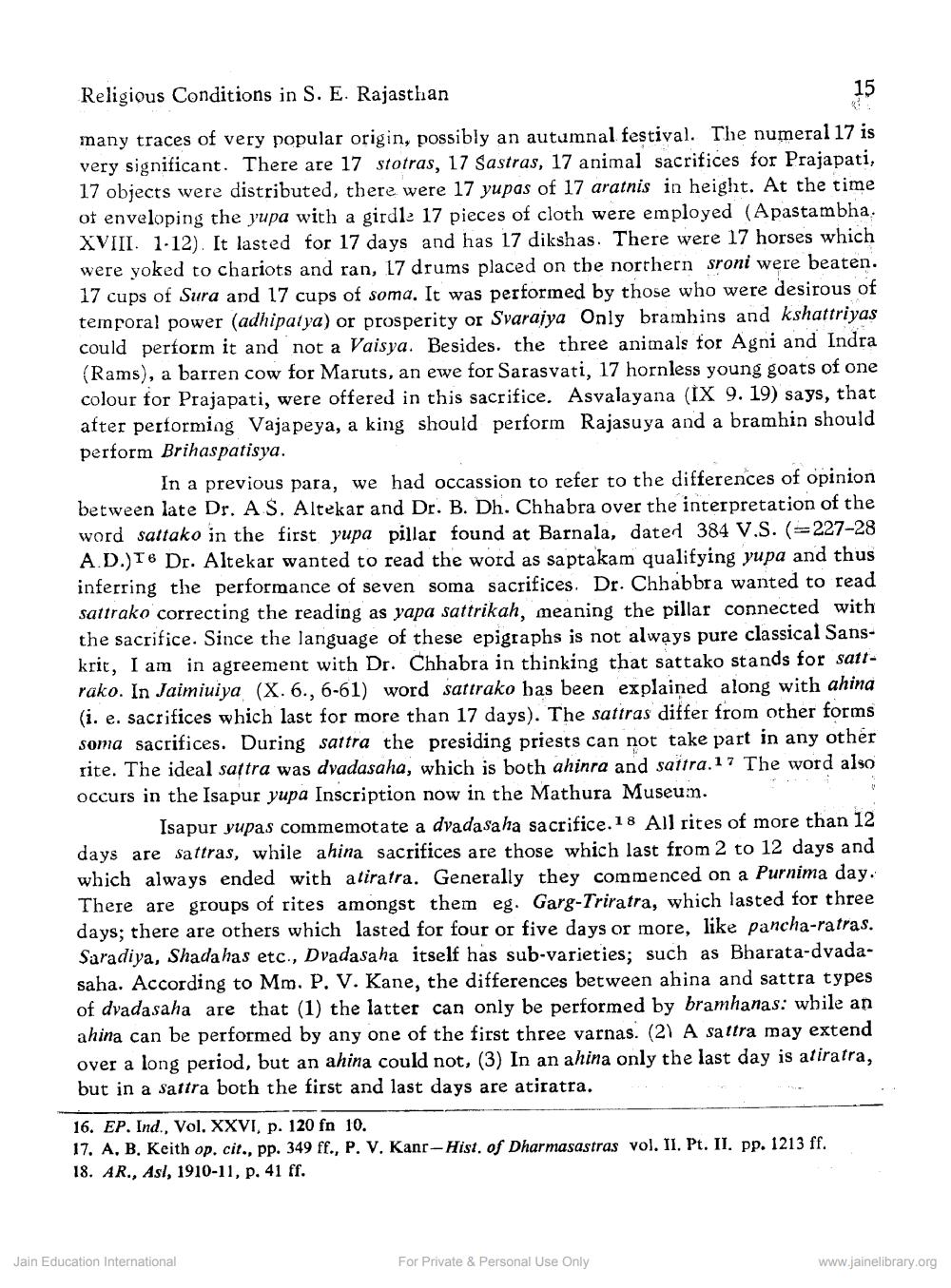Book Title: Religious Conditon in SE Rajasthan from early Inscriptions Author(s): Adris Banerji Publisher: Z_Jinvijay_Muni_Abhinandan_Granth_012033.pdf View full book textPage 5
________________ Religious Conditions in S. E. Rajasthan 15 many traces of very popular origin, possibly an autumnal festival. The numeral 17 is very significant. There are 17 stotras, 17 Sastras, 17 animal sacrifices for Prajapati, 17 objects were distributed, there were 17 yupas of 17 aratnis in height. At the time of enveloping the yupa with a girdle 17 pieces of cloth were employed (Apastambha. XVIII. 1.12). It lasted for 17 days and has 17 dikshas. There were 17 horses which were yoked to chariots and ran, 17 drums placed on the northern sroni were beaten. 17 cups of Sura and 17 cups of soma. It was performed by those who were desirous of temporal power (adhipatya) or prosperity or Svarajya Only bramhins and kshattriyas could perform it and not a Vaisya. Besides, the three animals for Agni and Indra (Rams), a barren cow for Maruts, an ewe for Sarasvati, 17 hornless young goats of one colour for Prajapati, were offered in this sacrifice. Asvalayana (İX 9. 19) says, that after performing Vajapeya, a king should perform Rajasuya and a bramhin should perform Brihaspatisya. In a previous para, we had occassion to refer to the differences of opinion between late Dr. AS. Altekar and Dr. B. Dh. Chhabra over the interpretation of the word sattako in the first yupa pillar found at Barnala, dated 384 V.S. (=227-28 A.D.)T6 Dr. Altekar wanted to read the word as saptakam qualifying yupa and thus inferring the performance of seven soma sacrifices. Dr. Chhabbra wanted to read sattrako correcting the reading as yapa sattrikah, meaning the pillar connected with the sacrifice. Since the language of these epigraphs is not always pure classical Şanskrit, I am in agreement with Dr. Chhabra in thinking that sattako stands for sattrako. In Jaimiuiya (X. 6., 6-61) word sattrako bas been explained along with ahina (i. e. sacrifices which last for more than 17 days). The sattras differ from other forms soma sacrifices. During sattra the presiding priests can not take part in any other rite. The ideal sattra was dvadasaha, which is both ahinra and saitra. 17 The word also occurs in the Isapur yupa Inscription now in the Mathura Museum. Isapur yupas commemotate a dvadasaha sacrifice. 18 All rites of more than 12 days are sattras, while ahina sacrifices are those which last from 2 to 12 days and which always ended with a tiratra. Generally they commenced on a Purnima day. There are groups of rites amongst them eg. Garg-Triratra, which lasted for three days; there are others which lasted for four or five days or more, like pancha-ratras. Saradiya, Shada has etc., Dvadasaha itself has sub-varieties, such as Bharata-dvadasaha. According to Mm. P. V. Kane, the differences between ahina and sattra types of dvadasaha are that (1) the latter can only be performed by bramhanas: while an ahina can be performed by any one of the first three varnas. (21 A sattra may extend over a long period, but an ahina could not, (3) In an ahina only the last day is atiratra, but in a Sattra both the first and last days are atiratra. 16. EP. Ind., Vol. XXVI. p. 120 fn 10. 17. A, B, Keith op. cit., pp. 349 ff., P. V. Kanr-Hist. of Dharmasastras vol. II. Pt. II. pp. 1213 ff. 18. AR., Asl, 1910-11, p. 41 ff. Jain Education International For Private & Personal Use Only www.jainelibrary.orgPage Navigation
1 ... 3 4 5 6 7 8 9
